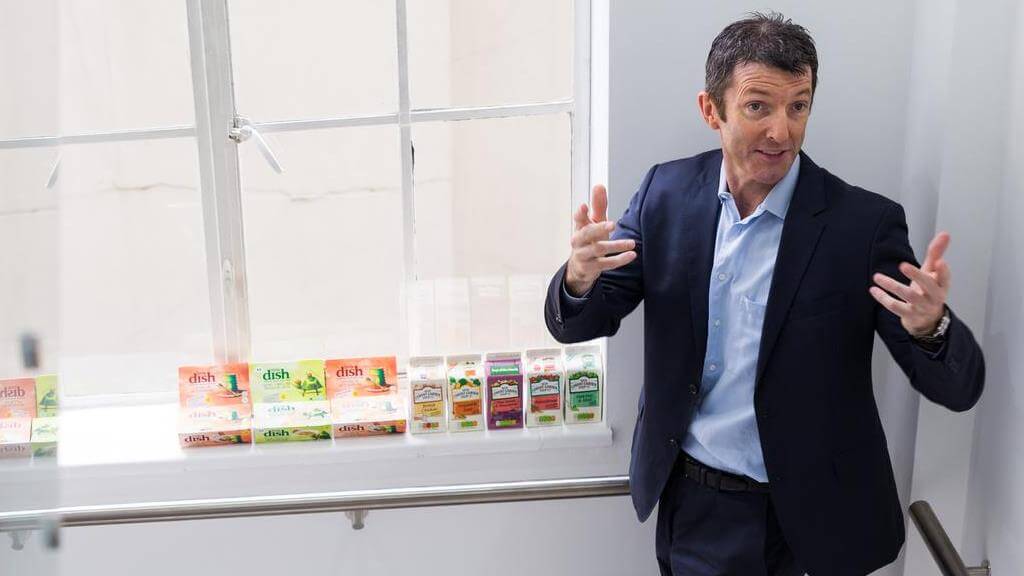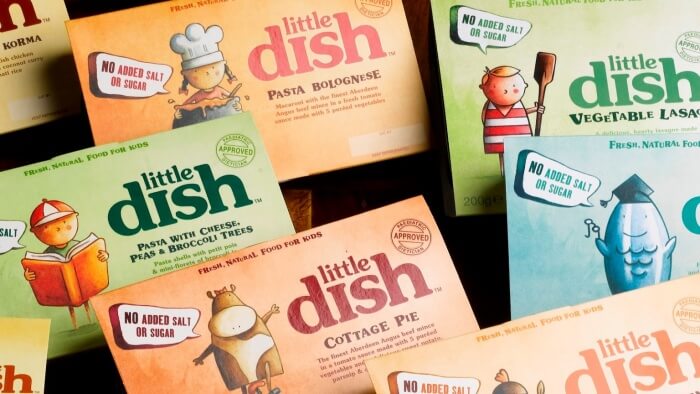Food is one of the most competitive businesses of all, so new entrants had better stand out or be swallowed up. Here's how John Stapleton achieved that not once but twice.
John Stapleton Builds Food Brands The Right Way
Food is one of the most competitive businesses of all, so new entrants had better stand out or be swallowed up. Here's how John Stapleton achieved that not once but twice.

The brains behind the New Covent Garden Soup Co and, more recently, Little Dish, John Stapleton understands how to create not just good food, but good food brands too. He tells MH why sceptical consumers still want food products to have personality.
With New Covent Garden Soup Co and Little Dish, you have been behind some fantastic brands – what’s the secret to winning the consumer over?
It’s all about building an emotional connection with the consumer. A great consumer brand speaks not only about the functional benefits of the brand but has a personality and brand essence that builds a relationship.
Starting off at New Covent Garden Soup, we were never quite sure who would buy our product and for what reason. What we knew was that we were selling quality combined with “naturalness”. We transformed the purchase of soup from a comfortable commodity to an exciting, quality-led experience for the consumer. The brand was recognised as aspirational, in bringing restaurant-quality soup to the home and consumers felt good about themselves when eating it.
Something similar can be said for Little Dish. It became clear quite early on that the consumer recognised that Little Dish also stood for quality and health combined with a fantastic taste - both really important for young kids. But it was the convenience element that made the difference and captured the consumer’s imagination. This was the major appeal among time-poor mothers of young children.
What have been your main challenges in establishing the brand?
Challenges come in many shapes and sizes and I suppose it is one of the virtues of an entrepreneur to quickly grow a thick skin and not be fazed by them. At New Covent Garden we faced criticism right from the beginning, from “its a crazy idea”; to “you’ll kill someone if you don’t completely sterilise the product”.
The main challenge in establishing a brand is developing a favourable measure of customer awareness. Coincidentally, the first major breakthrough for both New Covent Garden and Little Dish brands was a listing at Waitrose. This signified the beginning of trading in the High Street retailer chains – essential if one has national brand aspirations. This was followed by a successful trial and listing at Tesco, which proved the appeal of the brand to the mainstream market – again, quite significant.
Other breakthrough moments for Little Dish especially, although possibly less commercially significant in their own right, were the receipt of awards which demonstrated consumer recognition and our first glowing recommendation in blog form, from a happy busy mother. This was the first of many to follow which helped to establish Little Dish as a credible supplier of healthy, convenient tasty meals for toddlers, in the eyes of parents.
How did you know when it was the right time to exit the New Covent Garden Soup Co?
Quite honestly, apart from luck, you probably only realise when the right time to exit is once that point has already passed! It is extremely difficult to both predict and recognise the “right time”. At New Covent Garden Soup we always intended to sell the business but the question was “when?” It took 11 years and we almost certainly thought it wouldn’t take as long as that.
We recognised that the business had probably run its course with the existing management team. In order to take the next significant step, the brand and the business required new ownership with the resources and expertise to grow beyond the scale of we had reached in 1997 - a national brand with revenues of approximately £20m.
As a small, young and relatively inexperienced team at New Covent Garden, we had all learned a huge amount from the experience – something which perhaps an Ivy League MBA or 11 years at a corporate could never provide. Many of us wanted to head off and start something new with the benefit of a lot of relevant experience.
You took New Covent Garden Soup to the States, what challenges did you face taking the brand overseas?
Someone once said “the US and Britain are two countries separated by a common language”. This is very true and we found it to be the case at Glencoe Foods Inc. – the trading name for our fresh soup product in the States.
Some challenges were more difficult to overcome than others. Understanding consumer tastes was a major hurdle. We knew the best sellers in the UK would not be the same in the US.
Our solution to this was, on the face of it, both costly and time-consuming, flying soup manufactured in London to San Francisco and conducting an 18-month testing market in the Bay Area. It certainly was quite an expensive way to sell soup! But, we learned a lot, and in context it was very effective market research. Nothing ever makes up for lack of familiarity with your target audience.
"I’ve learned not to give too much credence to conventional wisdom"
We then had to deal with different expectations in convenience – i.e. shelf life. Americans, tend to have large refrigerators, carry out large, fortnightly shopping sprees and products must “have a lot of life on them”. Otherwise, products are considered to be inconvenient. The reality is that the longer life convenience requirement trumps the potential quality improvement of a shorter life product so prevalent in the UK.
We developed the process to achieve a 55 day shelf life while still being “Fresh” – something which consumers in the UK would never accept. This was quite a technical challenge (without compromising on quality) and required a large amount of time and resource investment up front. However, the result was the technical solution to support a much revised business model to that which we employed in the UK.
You decided to start from scratch with Little Dish. What made you want to go through it all again?
Well, on one level, I didn’t really know what else to do! I’ve never worked for a corporation and the entrepreneurial approach has always been in my blood. To a certain extent, I felt there was some unfinished business with the Glencoe project in the US. If one sees New Covent Garden Soup Co as a success, then one must recognise that Glencoe Inc. was a failure.
We didn’t achieve what we thought would be possible and we didn’t realise our expectations. I was keen to prove it could be done right again and Little Dish was born out of that ambition.
At the time, Jamie Oliver was creating a lot of headlines with his focus on the poor state of childrens’ diets and school dinners. My co-founder at Little Dish, Hillary and I believed there was a significant gap in the market for good quality, tasty and nutritious food for toddlers so we formed the company in 2005 and started trading in 2006.
Did you find it easy to get finance the second time around?
I don’t think it is ever “easy” to raise finance – especially in the food and drink industry. Innovation and new product development is alive and well in the sector and a large number of new and exciting brands have launched over the last 18 months. However, FMCG in general and food and drink in particular is often viewed by institutional investors as a commodity market.
Increasingly, the dominance of the ‘big four’ food retailers coupled with horror stories about how retailers squeeze their suppliers and treat them unfairly, have resulted in many investors hesitating to be the sole or even lead investor.
However, there is always room for new product ideas – especially if, as I indicated above, the product is meeting a widely-held consumer need and the brand is clearly communicating the solution to this need. People will always need food to eat and consumers will always be drawn to a brand to which they can relate.
When we were raising funds for Little Dish, I could leverage the success of NCGSC – which operated in a very similar space in the industry – i.e. fresh, chilled, healthy, natural, quality-positioned and convenient. In fact, on occasion, retailers merchandised both brands side-by-side.
But every venture is different and at Little Dish we were creating a new category again – with all the inherent risks that entails. Previous success in a closely-aligned sector is a great advantage but of course it doesn’t guarantee success.
What lessons have you learned along the way that have helped you in your latest venture?
I’m still learning. But in general, I’ve learned not to give too much credence to conventional wisdom. If we had done so at New Covent Garden Soup Co we would never have started the project. Many so-called experts told us we would fail or the concept would never work. As an entrepreneur you need to have faith on your vision and stick to what you believe will work.
I’ve learned to monitor performance on a daily basis and communicate it strongly and I cannot over-emphasise this enough. Firstly, in an FMCG business with a short shelf-life product being delivered to High Street retailers on a seven-day week basis, the business moves far too quickly to be relying on monthly Management Accounts for a steer on how the business is performing. One needs weekly often, daily KPIs to keep on track and to be able to react to issues or properly take advantage of opportunities.
Secondly, once everyone understands what part they play in the performance of the business and they can see, independently, the effect of the efforts they are contributing, this unlocks a synergy which is difficult to achieve in any other way. It’s almost as if; monitor and measure something and it improves of its own accord, simply because you are looking at it constantly.
Do you think that the UK business environment is favourable to entrepreneurs?
Living in Germany and having previously spent five years in California, I would say the environment and culture in the UK is favourable for business in general but for entrepreneurs in particular. The venture culture originally pioneered by the Thatcher governments and subsequently reinforced and encouraged by governments of all persuasions has led the UK to the front of this particular class.
Some have complained about the demise of the British manufacturing sector and the economy becoming over-reliant on the service sector. However, I believe recent governments have done a lot to encourage innovation, venture culture and entrepreneurism. Legislation has made it easier for businesses, particularly start-ups to invest in research and development, develop commercially-relevant IP and take their ideas forward to the marketplace.
There are two tax incentives worth noting which help and reward entrepreneurs and SMEs alike – the Enterprise Investment Scheme (EIS), which makes it easier to raise equity finance so crucial to early stage growth and Entrepreneurs’ Relief, for when founders finally sell their business to someone who is better placed to take it to the next stage.
These incentives have encouraged so many businesses to grow sustainably over recent years, retaining crucial talent in Britain and keeping innovation, jobs and much needed tax in the UK.
I am a great believer in capitalism with a social conscience (and not unbridled capitalism as epitomised leading up to 2008). It provides the incentives and freedom for businesses to thrive and for entrepreneurs to realise their dreams by ensuring businesses develop products and services which consumers or other businesses want and are prepared to pay for. Simply put, this means creating value and wealth and allowing that wealth to be shared with as much of society as possible.
What’s next?
I have recently stepped back to a non-executive director role at Little Dish, which has given me the opportunity to focus more on other projects – both in the UK and in Germany.
I now serve on a number of other boards as a non-executive director in addition to providing business advisory, guidance and mentoring services to growth-phase businesses in the FMCG sector. Essentially, I provide value-added input to businesses who can benefit from the experience I have gained over the last 25 years, building and growing consumer brands in the Food & Drink Industry.
I’m also a member of The Supper Club, through which I attend peer-learning dinners and events and I’m also on the 2015 Membership Committee. I’ve met some great businesses through the Club and having the opportunity to share my experiences and hear honest stories about other entrepreneur’s highs and lows has been invaluable.
Which businesses are your ‘ones to watch’ for 2015?
In the Food & Drink sector I’ve always liked brands which have managed to combine an appealing marketing position with sound product health credentials. One brand that seems to be doing everything right is Vita Coco. From an incredibly proactive distribution strategy to excellent consumer–focused brand awareness, combined with a health and well-being message that is really part of the zeitgeist, they enjoyed spectacular growth in 2014. It will be interesting to see if they can keep this up in in 2015.
They have spawned a wide range of copy-cat imitations, which is inevitable and other similar products such as Aloe Vera Drinks and even Birch Tree Water. If they can maintain their market share in a continuing growing market and indeed sector, they will have performed well this year.
In the wider context, Samsung have to be admired. They have taken the breakthrough technology of Apple and bettered it in almost every consumer-facing aspect and managed to steal the “coolness” appeal from iPhone. At the same time, they have placed the final nail in Blackberry’s coffin by providing secure and reliable features for the business customer. No mean feat!
Thanks for signing up to Minutehack alerts.
Brilliant editorials heading your way soon.
Okay, Thanks!

